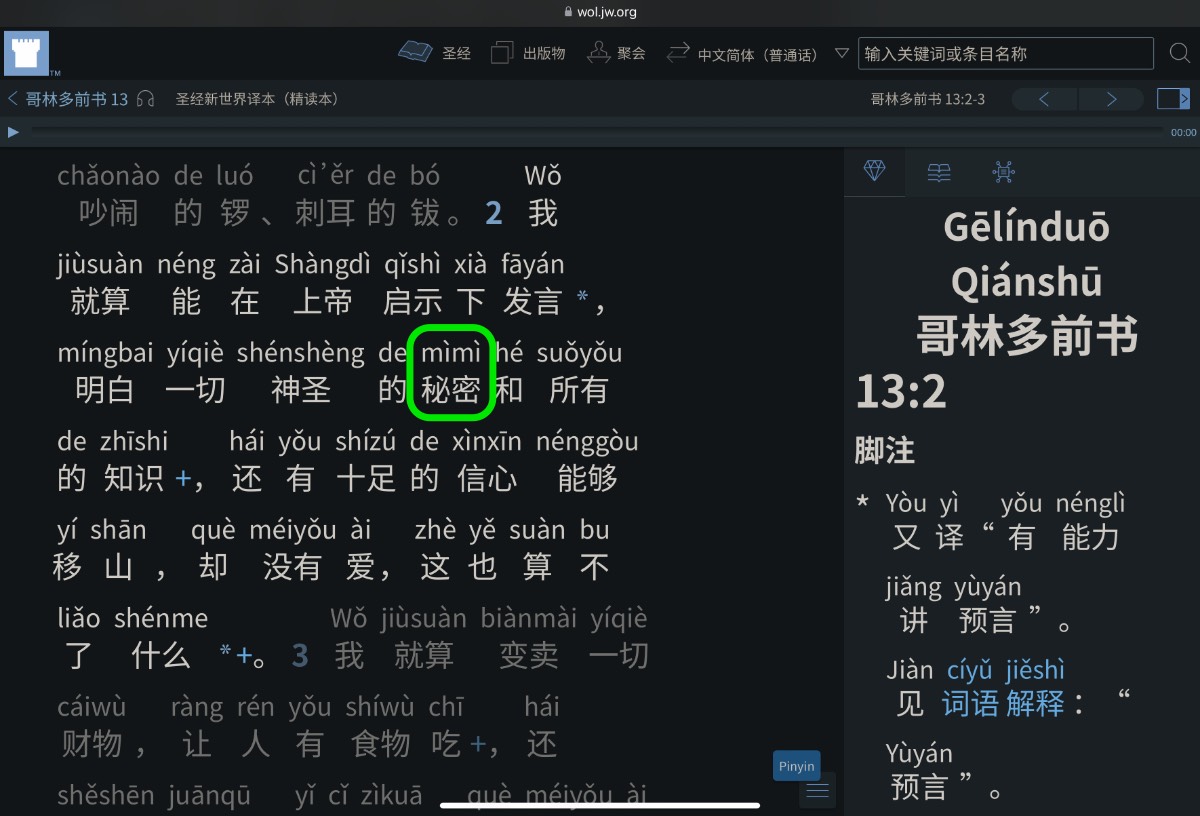bàogào (bào·gào reporting · telling → [reporting; making known | report; speech; lecture; talk] 报告 報告) ← Tap/click to show/hide the “flashcard”
[Notes: Tap/click on a Pīnyīn (Pīn·yīn {Piecing Together of} · Sounds → [Pinyin] 拼音) expression to reveal its “flashcard”; tap/click on a “flashcard” or its Pīnyīn (Pīn·yīn {Piecing Together of} · Sounds → [Pinyin] 拼音) expression to hide the “flashcard”. 📖 📄 📘 icons mean 📖 Reveal All, 📄 Reveal Advanced, and 📘 Reveal None re all the “flashcards” in the heading, paragraph, etc. that they are placed at the beginning of.]
At the time of this writing, jw.org was featuring a news item with the following headline:
English:
Adjustments to Field Service Reporting
Mandarin:
📖 📄 📘 Guānyú (Guān·yú {Closing → [Relating]} · to 关于 關於) Tiánxiě (Tián·xiě {Filling Out} · Writing 填写 填寫) Chuándào (chuán·dào Spreading · Way → [Preaching] 传道 傳道) Bàogào (Bào·gào Reporting · Telling → [Report] 报告 報告) de (’s 的) Gǎibiàn (Changings 改变 改變)
This week’s MEotW, “bàogào (bào·gào reporting · telling → [reporting; making known | report; speech; lecture; talk] 报告 報告)”, is used above to mean “report”.
Telling Reports
The “bào (reporting; announcing; declaring [→ [newspaper; periodical; bulletin; report]] | reply; respond; reciprocate | recompensing; repaying; requiting [→ [revenge; retribution | reward]] 报 報)” in “bàogào (bào·gào reporting · telling → [reporting; making known | report; speech; lecture; talk] 报告 報告)” basically means “reporting”. Unsurprisingly, it also makes an appearance in “bàozhǐ (bào·zhǐ reporting · paper → [newspaper] 报纸 報紙)”, the Mandarin word for “newspaper”, and it can even be used as an abbreviation for that word and mean “newspaper” all by itself.
The “gào (tell; inform; notify; explain | accuse; sue; {take sb. to court} | {ask for}; request 告)” in “bàogào (bào·gào reporting · telling → [reporting; making known | report; speech; lecture; talk] 报告 報告)” means “telling” in this context, and it’s also the “gào (tell; inform; notify; explain | accuse; sue; {take sb. to court} | {ask for}; request 告)” in the well-known expression “gàosu (tell 告诉 告訴)”.
While “bàogào (bào·gào reporting · telling → [reporting; making known | report; speech; lecture; talk] 报告 報告)” can be used as a verb, and while both of its morphemes are basically verbs, “bàogào (bào·gào reporting · telling → [reporting; making known | report; speech; lecture; talk] 报告 報告)” can also be used as a noun, as it is in the above-quoted headline. In such cases, it’s a verbal noun, or a gerundial noun.
Changing Technologies
Technologies? What technologies? Weren’t we just talking about field service reports? Well, what’s a technology, actually? Does it necessarily involve digital electronics? The article “Pīnyīn (Pīn·yīn {Piecing Together of} · Sounds → [Pinyin] 拼音) Was Plan A” touches on this basic question of what a technology is:
The word “technology” comes from the Greek words tekhnē (skill) and logiā (from logos, meaning word, speech), so at its root a technology is a set of words or speech (and thus the thoughts they represent) about a certain kind of skill—“skill speech”.
And what is a skill? A skill can be defined as a “capacity to do something well; technique, ability”. So, at root, a technology—a set of “skill speech”—involves a set of thoughts about a technique or an ability to do something, and hopefully, do it well.
How does that relate to field service reports? Well, field service reports are designed to have the ability to do something, are they not? In the case of field service reports, they are designed to enable the passing on of the information that the organization considers to be worth having about the field service activity of individual publishers. Since they are constructs designed to have the ability to do something, it can be said that field service reports are a technology, and if life in the modern era has taught us anything, it’s that technologies change as people keep searching for better and better ways of doing things. So, it shouldn’t be surprising that field service reports occasionally change, just like other technologies do.
Advancing Cultural Technologies
As Mandarin field language learners, it may benefit us to consider what the above-quoted article goes on to say about technologies:
Thus, it would be appropriate to think of writing systems, and even languages themselves, as cultural technologies. (Interestingly, they are technologies, or sets of “skill speech”, involving speech itself, and thus they are of basic, foundational importance to any and all other technologies, or sets of “skill speech”.) As cultural technologies, languages like Mandarin and writing systems like the Hànzì and Pīnyīn should be allowed and encouraged to progress, like other technologies are allowed and encouraged—expected, in fact—to progress for the benefit of all and not remain stagnant.
Yes, like the newspapers mentioned above have had to adapt to remain relevant as cultural technologies, it would be good for cultural technologies like languages and writing systems to continue to adapt and progress as well, so that those of us who use them can continue to benefit from them as much as we should be able to.
So, when it comes to field service reports, Chinese characters, or anything else related to our service to Jehovah, rather than indulging in nostalgia and clinging to the past, we should cultivate this attitude that the Bible advocates at Philippians 3:13, 14:
…Forgetting the things behind and stretching forward to the things ahead, I am pressing on toward the goal for the prize…
